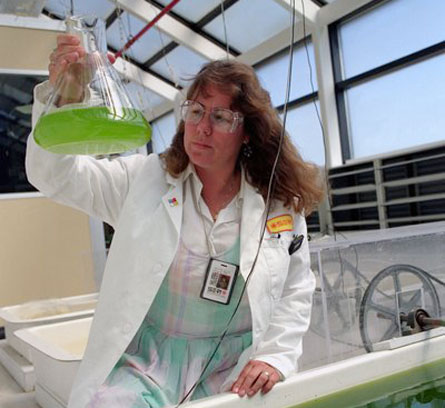- More than 2 years ago
Algae have emerged as a rising star among renewable fuels. But like any celebrity, the microorganisms still need the essentials to survive. The environmental footprint of providing algae with nutrients and water must be considered in judging whether algae will be competitive with other plant-based fuels, researchers report online January 19 in Environmental Science & Technology.

Microalgae are single-celled photosynthesizers. They make fats that can be converted into biodiesel or jet fuel in relatively few steps. The organisms have become a fledgling favorite in the renewable energy sector. On January 14 the U.S. Department of Energy announced an investment of $44 million in efforts to commercialize algae-based fuels, and last summer even ExxonMobil Corp. jumped onto the band-pontoon, announcing a partnership with scientist Craig Venter’s Synthetic Genomics Inc. to develop algae as a fuel source.
While the aquatic microorganisms show promise — algae are extremely efficient at converting carbon dioxide into biomass and don’t require a lot of land — they also come with trade-offs, the new analysis reports.
To get a better sense of algae’s perks and problems, a research team from the University of Virginia in Charlottesville examined the energy costs and environmental impacts of producing algae for fuel. The team then compared these with similar values from algae’s biofuel peers — corn, canola and switchgrass. The algal life-cycle analysis, which used numbers from an online database and published research, finds that algae farms need to minimize use of fertilizer and freshwater to compete with other biofuel plants.
One way to do this would be to put algae operations next to wastewater treatment plants or facilities that emit carbon dioxide. Municipalities should consider infrastructure changes that accommodate algae’s food and water needs, says environmental engineer and study coauthor Andres Clarens of UVA. Algae farms will have a much smaller energy footprint if they use recycled carbon dioxide, nutrients and water, rather than virgin products, says Clarens. In the analysis, algae production’s dominant energy inputs came from making the fertilizer and carbon dioxide fed to the tiny photosynthesizers, Clarens says.
That algae is not a silver bullet to solve the energy crisis should come as no surprise, says John Sheehan of the Institute on the Environment at the University of Minnesota–Twin Cities. Sheehan was head of the National Renewable Energy Laboratory’s algae research program when it was shut down due to budget cuts in 1996. “There aren’t any silver bullets,” he says.
“The energy problem is the most fundamental, most difficult challenge we have faced for a long time,” Sheehan says, and the new work underscores the complexity of transitioning from fossil to renewable fuels. “After 150 years of punching a hole in the ground and getting fuel to come out as a liquid, it is not going to easy.”
The analysis by Clarens’ team starts by considering an algae operation that approaches maximum inefficiency. The researchers examined the energy footprint of algae that is fed CO2 from tanks and synthetic nitrogen and phosphorous fertilizers. This approach puts the carbon column in the red, the researchers report. The only arenas where algae came off better than corn, switchgrass and canola were land use and nutrient runoff. Growing algae in wastewater and feeding it recycled nutrients and recycled CO2 greened up the process considerably, the researchers report. Researchers in the public and private sectors are already investigating these strategies, putting algae ponds next to facilities with CO2 emissions that can be captured.
Bypassing synthetic fertilizers is also crucial. Composting the remaining algae biomass after the energy-rich lipids have been extracted could supply a partial food source for the next crop of algae, Sheehan says. And using concentrated nutrients extracted from wastewater such as sewage — nutrients that require dilution before they are released into the environment — would also reduce the need for chemical fertilizer, Clarens and his colleagues note.
Clarens cites as an example technologies that involve “source-separated urine,” which can recover nitrogen from human waste before it is diluted in treatment plants. Such technologies may play an important role in supplying nutrients to the fuel sources of the future. “There are a lot of nutrients that we flush down the toilet,” he says.
Algae farming is still in its infancy, especially compared with crops such as corn that humans have bent to their will for centuries, notes Clarens. Large-scale algae production undoubtedly will improve on several fronts, he says. “Corn and canola we’ve been growing for a long time. We’ve gotten pretty good at it.” Someday, we might say the same for algae.







